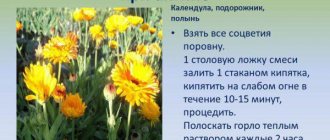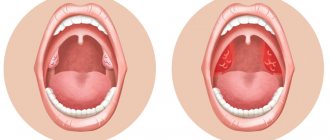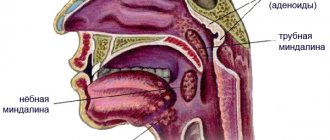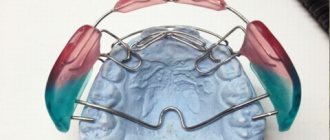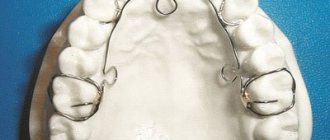How is ENT rinsing of tonsil lacunae done with the “Tonsillor” apparatus?
This procedure involves simultaneous exposure of the affected area to vacuum and ultrasound. The first exerts accentuated mechanical pressure on the tonsils, helping to effectively remove purulent plugs. Ultrasound has an anti-inflammatory and bactericidal effect. In addition, it improves blood supply to the ENT organs and helps to increase the effectiveness of drug therapy, which together accelerates the tissue healing process and the patient’s recovery.
AT WHAT AGE IS SURGICAL TREATMENT OF CHRONIC TONSILLITIS MOST OFTEN PERFORMED?
The operation can be performed at any age, in accordance with the existing indications for surgery. Due to anatomical features, children are recommended to undergo tonsillotomy - partial removal (cutting) of the tonsils or conservative therapy. Adults undergo tonsillectomy - complete removal of hypertrophied tonsils. The minimally invasive nature of surgical treatment of tonsillitis allows for surgical intervention with minimal tissue trauma, without significant blood loss and with a short rehabilitation period.
Tonsillectomy is one of the most common operations in the modern practice of ENT specialists. Despite this, patients must be monitored in the early postoperative period so that qualified Clinic staff can monitor the patient’s health status and, in case of signs of deterioration or complications, provide the necessary medical care.
Advantages of this method
The use of the "Tonsillor" device has a more gentle effect on the tonsils compared to mechanical cleaning. And thanks to the special design of the attachments, the doctor is able to reach the most inaccessible places without the risk of injuring the tissues of the oral cavity or causing serious discomfort to the patient.
The procedure is absolutely painless, as it is performed using an anesthetic and takes no more than 10 minutes.
ANESTHESIA FOR TONSILLECTOMY AND TONSILLOTOMY
Tonsil removal surgery can be performed under general anesthesia or local anesthesia. The decision to use one or another method of anesthesia is made by the doctor based on the medical history, examination results and examination of the patient. Local anesthesia today is rarely used in early childhood, since due to the mental characteristics of a child under 8-10 years old, he cannot calmly accept the operation. Therefore, we recommend that tonsillectomy be performed in childhood using short-term general anesthesia.
At the CONSTANTA Clinic, tonsillectomy is performed under video microscopy control. During surgery, an anesthesiologist is present in the operating room and fully monitors the patient's condition. Modern drugs that we use for general anesthesia are not accompanied by the development of complications characteristic of drugs used earlier. The patient quickly comes to his senses and recovers under the strict control of competent Clinic specialists.
What effect does this procedure give?
When completing a full course, which consists of 5-10 procedures, washing the lacunae of the tonsils with the device helps:
- complete cleansing of the oral cavity from pathogenic bacteria and their metabolic products;
- creating the necessary conditions for the penetration of drugs into the affected area;
- improving blood supply and cellular nutrition of tonsil tissue;
- reducing the inflammatory process;
- improving local immunity.
GENERAL ANESTHESIA FOR TONSILLECTOMY
Removal of tonsils under general anesthesia is used mainly in childhood. Before the operation, sedatives are prescribed. The anesthetic is administered intravenously, which allows the patient to quickly fall asleep. After this, the doctor begins to remove the tonsils. If during the use of local anesthesia the patient sits and is conscious, then during surgery under general anesthesia the patient is in the operating room in a lying position with his head tilted back.
The operation takes place quickly, under the supervision of experienced specialists. Tonsils are removed using a raspator, a tool that provides low-traumatic removal of hypertrophied tissue while preserving the functional characteristics of healthy mucosa. The vessels coagulate, so bleeding does not occur. The doctor carefully examines the tissue after removing the tonsils to assess the condition of the bed and blood vessels. It is important to perform the tonsillectomy as cleanly as possible, leaving no part of the tonsils behind. This will provide a guarantee against relapse of the disease in the future.
Contraindications
It is also necessary to take into account a number of contraindications to such a procedure. These include:
- ENT diseases in the acute stage (including acute tonsillitis);
- influenza, ARVI and other viral diseases;
- acute form of tuberculosis;
- negative reaction of the body to ozone;
- malignant neoplasms of any location;
- hypertension 3 degrees;
- blood clotting disorder;
- first trimester and last month of pregnancy.
What is the reason for this difference in approaches in the practice of Russian doctors and their colleagues from other countries?
First of all, the criteria on the basis of which the diagnosis of chronic tonsillitis is made are very different. In Russian medical practice, this diagnosis is often made based on an examination of the throat, even without assessing the patient’s history. In the practice of doctors from European countries, Japan, and the USA, such a diagnosis is rarely made, and based on a number of signs.
Patients who have been diagnosed with this can often hear about a “locus of chronic infection”, the risk of developing other diseases due to the fact that dangerous bacteria spread from the palatine tonsils to other organs and systems. Today this medical concept is outdated. Numerous studies and meta-studies have shown that only one disease has a risk of spreading beyond the tonsils - tonsillitis or, in scientific terms, “streptococcal acute tonsillitis”.
Sore throat is a disease caused by certain bacteria that are easily transmitted from person to person. If a patient suffers from tonsillitis more than 2-3 times a year for several years, the tonsils need to be removed. This is the only measure that, from the standpoint of modern science, can help the patient in this situation and negate the risks of developing other diseases.
Rinsing the tonsils does not reduce the risk of developing tonsillitis.
What needs to be done first?
Before starting treatment procedures, it is recommended to visit an otolaryngologist. You may also need to undergo the following examinations:
- general blood analysis,
- bacteriological examination of the tonsil area,
- rheumatic tests.
To avoid possible discomfort caused by the gag reflex, it is strongly recommended to carry out the procedure on an empty stomach. That is, the last meal and water should be taken at least 3 hours before visiting the clinic. And after washing the tonsils, you must not eat or drink for another 40-60 minutes for the treatment to proceed properly.
More accurate information can always be obtained by making an appointment by phone.
FEATURES OF THE POSTOPERATIVE PERIOD
Despite the fact that tonsillectomy is one of the most common operations in modern otolaryngology, the patient’s condition must be monitored by qualified specialists in the postoperative period. The patient is transferred to the ward on a gurney or in a sitting position, depending on the type of anesthesia used. For quick recovery, it is recommended to use dry ice every two hours for 5-15 minutes. This prevents the appearance of swelling and inflammation.
Feeling is restored a few days after the operation. During the first day, you should not swallow saliva - you need to keep your mouth slightly open so that it flows by gravity. In the early postoperative period, you should not talk. If minor sore throat occurs, the doctor will prescribe a pain reliever. He also recommends the use of non-steroidal anti-inflammatory drugs, which, in addition to the analgesic effect, prevent the development of an inflammatory reaction. In general, patients tolerate the operation easily and can return to their usual activities almost immediately.
During the first days after surgery, you can eat mostly soft, pureed foods. Avoid hot drinks. According to indications, specialists can prescribe medications to prevent bleeding. Antibacterial drugs are used to prevent the development of infectious complications.
For two weeks after surgery, physical activity is limited. It is forbidden to visit the bathhouse or actively engage in sports. You should also not actively gargle for the first days after tonsillectomy.
Washing of tonsil lacunae price
The cost of washing the lacunae of the tonsils with the Tonzillor apparatus is only 300 rubles per session. The number of sessions depends on the complexity of the disease. However, the positive effect is felt after the first procedure.
Chronic tonsillitis is a disease fraught with serious complications, including from the cardiovascular system. Therefore, you should not let it take its course. Trust the professionals - come to Stoletnik!
Make an appointment by phone: +7 (841 2) 999-395, 76-44-20.
We care about your health
Tonsillitis is a common pathology of the oropharynx. Factors in its development are infectious agents such as viruses, bacteria, and sometimes fungi. The disease attacks the palatine tonsils , the immune defense organs of the human body. In addition, the tonsils have a hematopoietic function. Their inflammation is accompanied by pain, sore throat, enlarged submandibular lymph nodes, and tonsil lacunae with purulent contents. Patients also note general symptoms - malaise, headache, fever, chills and joint pain - the main signs of intoxication of the body.
An examination by an ENT doctor can detect plaque on the surface of the tonsils (depending on the location of the process - on one or both sides), swelling and redness of the mucous tissues of the throat. In children, the course of this disease is more severe - convulsions, attacks of suffocation, abdominal pain with signs of dyspeptic disorder - nausea and vomiting may be added to the above symptoms.
Treatment of tonsillitis is complex and consists of taking antibacterial agents in accordance with the dosage prescribed by the doctor. In severe cases, anti-inflammatory drugs are indicated. Local treatment of tonsillitis is gargling with antiseptic solutions, physiotherapy, and rinsing the tonsils. It is better not to delay the treatment of this disease - tonsillitis tends to become chronic.
It is for severe and chronic forms of tonsillitis that there is an effective method of influencing the source of inflammation - washing the tonsils . Previously, this procedure was performed using a syringe with a medicinal solution, the mouthpiece of which had a slightly curved probe with a blunt end.
In modern medicine, more advanced methods of washing the lacunae of the tonsils have appeared - the Tonsillor apparatus . The effectiveness of use has been proven - foci of infection quickly disappear, the inflammatory process subsides. Cases of relapses when using Tonsilor are observed less frequently, and the risk of recurrent pharyngitis and acute sore throat is reduced.
The principle of Tonsilor's effect on the tonsils is a vacuum, which is created through the energy of ultrasound vibrations. That is, this physiotherapy procedure is complex - both phonophoresis and ultrasound are present.
The waves act directly on the source of inflammation and promote the regeneration of affected areas. The procedure does not require any special preparation. Especially if it is performed for the first time on a patient. It is also suitable for children, so the task of parents and the doctor is to calm the child. Otherwise, the manipulation cannot be carried out.
The person does not experience any significant pain during the procedure – perhaps it is only somewhat unpleasant. If the patient has an increased gag reflex or is extremely sensitive to pain, he will be anesthetized by irrigating the throat with a local anesthetic - lidocaine, novocaine.
Washing the tonsils with the Tonsillor apparatus - photo
Tonsillor device Washing tonsil lacunae - photo
Washing the tonsils with Tonsilor is performed in 2 stages:
- Stage of deep cleaning of tonsils;
- Stage of washing the tonsils.
The first stage involves attaching a special cup to the tonsil, which is tightly suctioned to the surface of the mucosa. The device creates a vacuum in the resulting space, and purulent plugs come out of the lacunae. When using other methods of washing, it is not possible to achieve such an effect - the surface of the tonsils has many depressions, which, even with the most thorough cleaning, are inaccessible to the syringe. The vacuum created by Tonsilor is a kind of vacuum cleaner that processes the affected surface.
The next stage is the rinsing of the lacunae of the tonsils . An antiseptic solution is applied to the surface of the tonsils using special tubes - they treat them from all sides, penetrating even the smallest voids and depressions. Anti-inflammatory drugs are injected into the tonsil using ultrasound.
The duration of the procedure is no more than 10 minutes. The frequency of execution is from 7 to 10 times, depending on the degree of damage to the tonsils and surrounding tissues. One procedure will not have the desired effect on foci of infection. The procedure is atraumatic and is performed in an outpatient setting. The use of the Tonsilor device for washing the tonsils is a good alternative to tonsillectomy.
Indications for manipulation are acute and chronic rhinitis, chronic and acute tonsillitis, adenoids, otitis media.
But this manipulation also has contraindications - dysfunction of the autonomic nervous system, open form of tuberculosis, arterial hypertension, malignant neoplasms of any location. Relative contraindications include pregnancy in the first and third trimester, infectious diseases in the acute phase (if there is a rise in body temperature). Normal body temperature readings allow the procedure to be performed in case of infection. Retinal detachment is also a relative contraindication; an ophthalmologist must be consulted before the procedure.
Preparation for washing tonsil lacunae with the Tonsilor device includes:
- The last meal should be taken no later than an hour before the procedure - this will serve as a prevention of the gag reflex, which does not bother patients so much after the 2-3rd procedure;
- During the procedure, behave calmly and sit up straight. It is not recommended to throw your head back;
- Breathe evenly and calmly;
- After the procedure, refrain from drinking and eating for 2 hours - this will ensure better absorption of the drug.
Tonsil rinsing in Moscow can be done in our clinic - highly qualified, attentive ENT specialists and the latest equipment are waiting for you.
You can make an appointment by phone. + 7 (499) 288-88-14
Indications for cauterization of tonsils
The surface of the tonsil has depressions - lacunae, they are needed to increase the area of the “working” surface. Allergens and microbial agents, when they enter the mucous membrane, cause an immune response from the body. Chronic inflammation leads to the formation of non-functional scar tissue, the lacunae narrow, and their drainage is impaired. All this leads to the accumulation of caseous plugs in the lacunae. If there are no indications for complete removal of the tonsils, then conservative treatment is carried out: washing the lacunae, physiotherapy. However, soon the lacunae are again “clogged” with plugs and the symptoms of the disease make themselves felt. To improve the functioning of the tonsil, it is recommended to carry out cauterization (ablation). The essence of this procedure is that the superficial layer of the tonsil is bloodlessly removed using a laser or radio wave. After this procedure, purulent plugs do not accumulate in the gaps, their size is reduced, the surface becomes smoother, and inflammation decreases. This way it is possible to achieve stable remission of the disease.
Washing your nose and throat at home - can you save money?
See also Treatment of ENT diseases Treatment of viral sore throat in children Treatment of sore throat in adults Cough in a child
There is a necessary minimum of hygiene procedures that not only can, but should be carried out at home, for example, gargling or moisturizing the nasal mucosa with a physiological solution. Rinsing the tonsils is not one of these procedures, since it is almost impossible to do it at home. At home, this manipulation is carried out almost blindly, which significantly increases the risk of damage to the mucous membrane and reduces the effectiveness of getting rid of plugs. Experienced ENT doctors note that microtraumas on the tonsils contribute to the worsening of the inflammatory process, so it is better to go to a medical clinic for rinsing.



